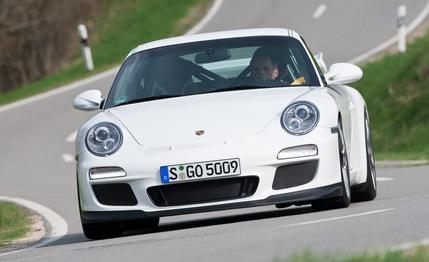
 First Drive Review
First Drive Review
To many people, the Porsche 911 Carrera is the definitive sports car, but in the 911 family, the top jock is the GT3. The current 997 family of 911s has been undergoing a major round of updates, and now it’s the GT3’s turn.
No Replacement for Displacement


Since GT3s are all about going—and feeling—fast, it’s no surprise that an upgraded engine is part of the changes for this second-gen of 997. A bore increase—from 3.9 inches to 4.0—raises displacement from 3.6 liters to 3.8. The bigger engine gets hotter cams with greater valve lift and the addition of variable valve timing to the exhaust cams (the intakes already had it). All together, these changes boost power from 415 ponies to 435 and torque from 300 lb-ft to 317. Despite the displacement increase, the engine’s redline climbs from 8400 rpm to 8500.
Oddly, the new engine does not get the direct fuel injection that is rapidly spreading through the rest of the Porsche lineup, mostly because the GT3 engine is a race-derived unit that remains distinct from the mainstream models. Unlike the Carrera and Boxster engines, the GT3’s has a proper dry-sump lubrication system with a remote oil tank and seven oil pumps. It also uses titanium connecting rods and is constructed with cylinder blocks that are separate from the crankcase halves. This engine is extremely robust and develops substantially more power in racing applications, revving to over 9000 rpm with standard components.
Grip Increases, Too
The next most important change is a set of bodywork revisions that roughly triple the car’s aerodynamic downforce. A redesigned front end provides a more efficient exit for the air flowing through the center radiator through new ducting to a vent just forward of the trunklid. The front splitter is lower and deeper. In the rear, a wider wing extends beyond its vertical supports and is tilted down at an angle of 7.8 degrees, which translates into about a 20-degree angle relative to the airflow, which is following the downward slope of the rear window. Together, these changes increase downforce from 66 pounds at 186 mph to 220 pounds.
A revised suspension makes the most of this additional force pressing the tires into the pavement. Front spring rates are stiffer by 12 percent, and the anti-roll bar drops from 1.1 inches in diameter to 1.0. In the rear, the anti-roll bar increases from 0.9 inch to 1.0. The PASM adjustable shock absorbers have been completely recalibrated, and the suspension pickup points have changed, thanks to new hubs. These hubs now accommodate center-lock wheels, employing the same large nuts introduced on the Carrera GT. This design makes for a lighter wheel, saving a total of 6.6 pounds. But with only one nut holding each wheel in place, the tightening torque is a massive 331 lb-ft. You can apply this by being really strong, using a very large torque wrench, or springing $400 for a trick socket that incorporates a small planetary gearbox to multiply the torque from a normal-size wrench. Nobody ever said Porsche speed was cheap.
Focused On Control
Other major upgrades include enormous 15.0-inch front brake rotors with separate aluminum carriers that actually reduce their weight slightly. The pricey, optional Porsche Ceramic Composite Brakes also get lighter carriers, and their use shaves 44 pounds from the braking system. For the first time, the GT3 also gets stability control in the form of a specially calibrated Porsche Stability Management system that allows you to turn off the stability control alone or the stability control and traction control together. When these systems are shut down, they do not reactivate, as they do on other Porsches, when you start losing control in a corner under braking.
One innovative new option is PADM, which stands for Porsche Active Drivetrain Mounts. These are hydraulic engine mounts using magnetorheological fluid so their stiffness can be varied according to a programmed map. At high revs they get stiffer to provide a more precise feel by reducing the relative motion between the powertrain and body. Another new option is a front-axle lifting feature, which raises the car’s front end by 1.2 inches when you press a button on the dash. This should help you avoid shredding the effective new front splitter at that local service station with the clifflike ramp.